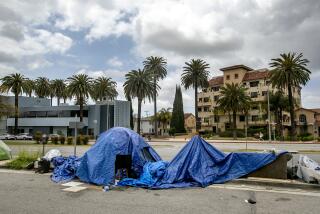‘I Knew That . . . My Life as a Normal Person Was Over’
- Share via
He was a dapper young man, working at his first job as a draftsman for the Texas Highway Department, when leprosy struck in 1935. Johnny Harmon noticed one day that the little finger on his left hand had lost sensation. He soon discovered a bloody print on a highway drawing he was doing and found that he had unknowingly worn the skin off his left elbow.
Harmon knew right away that it was Hansen’s disease. His older brother, Elmo, was already hospitalized with the disease at the federal facility in Carville. “I knew . . . that my life as a normal person was over, that I would soon join the dominion of the exiled,” he said.
The diagnosis ended his dream of becoming an engineer. So Harmon, who had always longed to travel, quit his job and drove to California with his cousin. “I wanted to see some of this beautiful country of ours before I surrendered my freedom,” he said.
At Carville, Harmon found his brother in declining health. The only treatment available at the time for Hansen’s disease was chaulmoogra oil, a honey-colored substance that he found tasted like a mixture between cod-liver and castor oil. It often caused severe nausea and vomiting.
So when doctors asked for volunteers to test an experimental heat treatment, Harmon became one of six patients to try it at a New Orleans hospital. They placed him in the “fever machine,” a cylinder that gradually raised his temperature. Harmon made it through three treatments without a problem but nearly died in the fourth session. He was told that his temperature hit 106.8 degrees. “I went hog-wild crazy, tried to get out of the thing,” he said. “But right after that I started running negative tests [for Hansen’s disease bacilli].”
The first negative result was followed by 11 others. Harmon was discharged March 18, 1938. He reclaimed his job at the Texas Highway Department and tried to resume a normal life. But he was reluctant to marry, not knowing if the disease would return. His brother died of leprosy after Harmon was discharged. His fears about his own health proved prescient; 4 1/2 years after his release, he experienced a relapse and checked back into Carville.
During his second stay, he fell in love with another patient, Anne Louise Triche, who was 12 years his junior. They married but vowed not to have children.
When she nevertheless became pregnant in 1950, they faced the difficult decision of what to do with their son. Children of patients were not allowed at the Carville facility. If parents could not find someone to care for the youngsters, they were put up for adoption.
Harmon’s sister refused to take the child, so he turned to a distant relative who already had seven children. The family lived in a house with no running water. “They were really poor folks, as poor as we were,” Harmon said. “But this lady was so nice and she took the child and did such a wonderful job.”
So good, in fact, that the Harmons called on her again when their daughter Annemary was born a year later. “In those days, they wouldn’t let the children visit us,” Harmon said. “So we crawled through the hole in the fence two to three times a month and picnicked along the Mississippi with the kids.”
The hole in the fence, repaired repeatedly, is a theme that runs through all the decades of Carville stories.
Although in the early years the periphery was tightly controlled, as time went by and treatment improved, the staff was more likely to look the other way when patients disappeared briefly. Today, when patients can come and go freely, the hole still exists, a rusty reminder of the past.
The couple never hid their disease from their children. “We always thought it was better to tell them the truth,” Harmon said.
This extraordinary arrangement was accepted readily by the children. “I knew this lady, Mamere, wasn’t really my grandmother,” said Harmon’s daughter, Annemary Brett. “I knew that we weren’t a typical family, but it was not a big deal. It never seemed unusual to me.”
When Harmon tested negative for the disease in 1954, he faced another upheaval. Public health laws were changing, a reflection of the improved treatment for leprosy. Harmon was no longer permitted to live at the facility that had been his home for nearly two decades. His wife, who still tested positive, would have to remain.
He moved to Vacherie, La., a small town about 50 miles from Carville, to be near his young children and turned a hobby of photography into a thriving business taking wedding and graduation pictures. His wife joined him in 1957 after her discharge.
The couple still feared giving their children leprosy, so the youngsters continued living with their foster parents during the week and spent weekends and vacations with their parents. “We would go visit them and they were so paranoid about us getting the disease that before we could take a bath in their tub, they would scrub it with Lysol and Comet until it sparkled,” Brett said.
The Harmons also visited their children every Wednesday night to have dinner and help with homework, something that their illiterate foster parents could not do. The couple stressed the importance of education, and both children eventually graduated from college.
Through the years, “everybody just accepted us,” Brett said. “We never, ever felt ostracized or outside the community. . . . I’m very proud of my parents for going through what they did. Most people would just throw in the towel and say ‘I can’t do this.’ ”
As long-term patients at Carville, the Harmons were eligible to return to the facility at any time for care. They came back in 1993, intending to spend the rest of their lives there. Then they learned of the possible transfer of the facility to the state of Louisiana.
“I don’t mind them bringing in a bunch of kids here, but I don’t want to give them the whole place,” Harmon said. He would like to stay.
More to Read
Sign up for Essential California
The most important California stories and recommendations in your inbox every morning.
You may occasionally receive promotional content from the Los Angeles Times.













